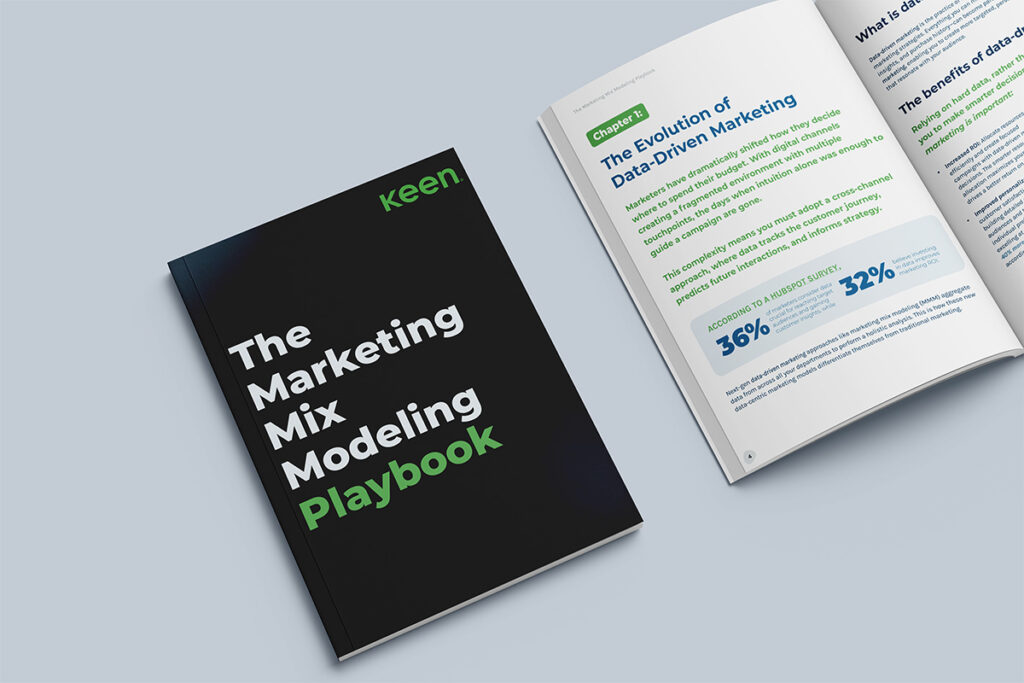In this episode, we unpack the comprehensive findings from Keen Decision Systems’ first annual marketing performance and strategic investments guide. Keen CEO Greg Dolan is joined by the report’s author, VP of Strategy and Insights Justin Jefferson, to explore the major trends shaping the modern marketing landscape.
This isn’t just another trend report. The insights are drawn from Keen’s marketing elasticity engine, a patent-pending database informed by 40 years of academic research and the real-world performance of 350 brands managing $7.5 billion in marketing spend. Greg and Justin dive into the data to reveal how investment strategies are evolving, what the numbers say about the optimal marketing mix, and where marketers should focus their budgets for maximum, sustainable impact in the coming year.
Key Takeaways
- Brands increased their marketing investments by about 15% in 2024 and saw an 8% rise in ROI.
- Investing 7% to 9% of your budget in emerging channels allows for testing without significant risk.
- Linear TV still commands about 20% of the marketing mix despite consistent declines year over year.
- The optimal marketing mix for mature brands is approximately a 65/35 split between top-of-funnel and bottom-of-funnel activities.
- Smaller brands tend to focus on the bottom funnel, but must shift toward brand building to ensure sustainable growth.
- Google Search remains a dominant force, comprising about 25% of total advertising budgets.
- Top-of-funnel marketing investments are crucial for long-term brand equity and make bottom-funnel tactics more efficient.
- Brands often overspend during peak seasons and underspend on the “shoulder” periods leading up to and after those peaks.
- Streaming video and retail media networks represent significant growth opportunities for marketers in 2025.
- Understanding the long-term decay rate of marketing is key to capturing the full value of your investments.
The Big Picture: 2024 Investment and ROI Trends
To set the stage, Justin provided a high-level view of the shifts observed over the past year. In a sign of confidence and the continuous drive for growth, brands are investing more in marketing and seeing a solid return on that increased spend.
“At a high level, what we have seen for 2024, we’ve been able to see roughly around a 15 percent increase in the overall amount of investment year over year for our brands. Roughly, the ROI increase that we saw was around 8 percent.” – Justin Jefferson
This growth provides a foundation for the deeper questions: Where are those investment dollars flowing, and which channels are truly delivering the most value?
Navigating the Fragmented Media Landscape
The marketing world has never been more complex. The days of simple media plans are long gone, a point Greg highlighted from his own experience.
“It’s crazy. When I started my marketing career 25 years ago, I had, like, four channels to choose from. It was like TV, print, and radio. And now there’s hundreds, if not thousands, of channels.” – Greg Dolan
This fragmentation creates a real challenge for marketers deciding how to allocate budgets between established platforms and emerging ones like TikTok or the ever-expanding universe of retail media networks. Justin explained that while testing new channels is crucial, the investment is still rightly conservative.
“Roughly what we’ve seen is maybe about 7 to 9 percent going towards the newer emerging channels… You know, really things that you might not have done before, but you want to test out.” – Justin Jefferson
Even with the undeniable trend toward digital, legacy channels like linear TV still hold a significant place. It’s not about abandoning what’s worked in the past, but finding the right, evolving balance.
“The trend is towards digital, but it’s not going to a hundred percent… Linear TV is something that we’ve seen consistently falling year over year, but it still holds a 20 percent kind of position, if you think about the overall mix.” – Justin Jefferson
The Critical Balance: Top vs. Bottom Funnel Marketing
One of the most persistent questions in marketing is how to split the budget between long-term brand building and short-term performance activities. The answer, according to the data, is nuanced and depends heavily on the size and maturity of your business.
Justin pointed out that smaller brands naturally lean on bottom-funnel tactics because the results are immediate and easier to justify.
“The smaller the business you are, the less budget you probably have and the more accountable you are to every single dollar that you have to put in market… And so bottom of funnel is very prevalent in younger, newer brands, smaller brands.” – Justin Jefferson
However, an over-reliance on the bottom of the funnel is a short-term strategy. To achieve sustainable growth, a shift is necessary. As brands grow, particularly past the $50 to $100 million revenue mark, the optimal mix moves closer to a 65/35 or 70/30 split in favor of the top of the funnel. Greg described brand building as a long-term asset.
“I think that’s hurting a brand’s ability to be competitive and sustainably grow over time because they don’t have that equity and they’re not building it, and it’s like a muscle that you’re building over time.” – Greg Dolan
Justin added that focusing only on capturing existing demand is a finite game. You eventually need to create more demand.
“If you over-index on the bottom, you’re kind of really capturing everything that’s there, and you’re gonna run out. At some point, you have to keep filling that funnel from more investments.” – Justin Jefferson
He shared that simply reallocating funds from the bottom to the top isn’t always the best move. Often, the most powerful strategy is to secure incremental budget for the top of the funnel, which then acts as a force multiplier, making your existing bottom-funnel spend even more efficient.
The Hidden Value: Marketing’s Long-Term Impact
A key theme of the discussion was the importance of measuring the full, long-term impact of marketing, not just the immediate sales lift. This is where the concept of marketing decay rates becomes essential.
Justin explained that different tactics have different lifespans.
“If you’re investing in a short term tactic, you know, you’re getting pretty much all of your bang for your buck in the first month or two… But if you think about your long term investments, that’s actually where you’re really getting only maybe 30, 40 percent in that first kind of month or two, and you’re really benefiting from that long term value.” – Justin Jefferson
He uses the analogy of “building on layers of rock” to describe how a consistent top-of-funnel presence creates a higher baseline of demand, making all subsequent short-term activations more effective. Capturing this long tail of impact is how Keen’s platform achieves its high degree of forecasting accuracy, accounting for revenue that is often left unattributed.
Where to Invest and Optimize in 2025
Looking ahead, Justin provided clear guidance on where marketers should be thinking about reallocating their budgets.
- Streaming (OTT/CTV): “Streaming is something right now that we think a lot of people are underutilizing. We’re seeing a lot of success from those diving into it… we would consider any of the OTT, CTV channels that you might be able to leverage, test them out.”
- Retail Media Networks: These channels are growing, but caution is advised. Brands are often pushed to spend more than is optimal. The key is to work with retailers to balance investments across their on-site (bottom funnel) and off-site (top funnel) properties.
- Social Media: Consumers are on social, so brands need to be there too. The challenge is finding the right mix between platforms like Meta and TikTok and not just chasing the latest trend. “Don’t over-index on one just because that’s the newest trend,” Justin warned. “We call it marketing FOMO.”
Beyond where to spend, the discussion turned to how much and when. It’s crucial to look past historical ROI and analyze the marginal return on your next dollar. They see frequent overspending in social and linear TV.
Timing is also critical. Many brands make the mistake of concentrating their budget too heavily in peak seasons and then going dark.
“What we have seen is historically brands are slightly overspending on that peak, but underspending on the shoulders… And in some of the off season, don’t go dark. At the end of the day, you need to still have a presence, and it’s a lot harder to make your dollars work for you when you’ve been dark for a while.” – Justin Jefferson
Final Words of Wisdom
As the episode wrapped, Justin offered a final checklist for marketers heading into 2025:
- Find the right budget level based on your brand’s size and revenue.
- Be gradual when shifting to new channels; don’t go all-in at once.
- Increase your top-of-funnel investment. If you are not at a 70/30 split, find ways to move in that direction.
- Evaluate your performance based on marginal returns, not just overall ROI, to avoid wasted spend.
- Dedicate a budget for testing to find new ways to connect with your consumers.
And as Greg added, the ultimate key is to have a system in place to track, measure, and optimize on an ongoing basis to ensure you are achieving your goals.
To get all the charts, data, and detailed analysis, be sure to download the full Keen’s Marketing Performance and Strategic Investment Guide.


